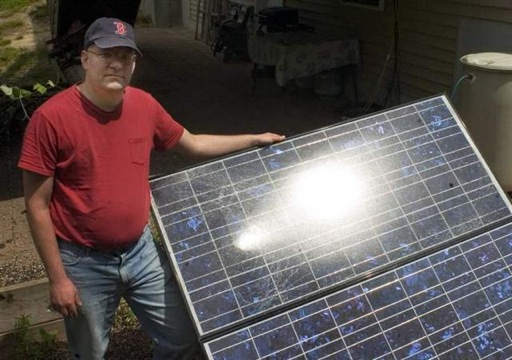
Wednesday, June 17, 2009
Grants go green
Utility helps homeowners to get rebates

Troy Bottger has a solar array on the roof of his Templeton home and a small test array in his yard. (T&G Staff / RICK CINCLAIR)
By George Barnes TELEGRAM & GAZETTE STAFF
gbarnes@telegram.com
TEMPLETON — The Templeton Municipal Light and Water Plant already is working on a windmill, supporting a methane-to-power project, and helping homeowners with solar projects.
Now the town-owned power company is hoping that going with green power will be money in the bank for its customers.
General Manager Sean Hamilton said the Templeton utility is the first of the state's municipal power companies to join the Massachusetts Renewable Energy Trust. By joining, the town, its residents and businesses are in a position to get grants, rebates and other incentives to help pay the cost of green energy projects, he said.
The trust was set up by the state under the 1998 Electric Utility Restructuring Act to promote renewable energy. When it was created, municipal power companies were not eligible to participate. Since then, with the move to pass the 2008 Green Communities Act, municipals indicated an interest in participating and the law was changed, said Lisa Capone of the state Executive Office of Energy and Environmental Affairs.
Under the law, the municipals are able to enjoy the benefits of green energy incentives, but do not have to meet the renewable portfolio standards set for investor-owned utilities that require them to increase the amount of green energy they sell to their customers each year.
Templeton homeowners will be eligible for wind and solar power incentives if they install systems in their homes. Homeowners can receive incentives for installing up to 10 kilowatts-per-hour wind turbine systems for their homes and 5 kilowatts-per-hour solar systems. So far, the state has given $8,672,000 toward the installation of 618 residential solar systems, with an average rebate of 41 percent. For homes, businesses and public solar systems, it has awarded $29 million. The wind systems will receive rebates of up to $4 per watt.
Businesses also have rebates available for installing 10-kilowatt wind systems and up to 500-kilowatt solar systems. Communities also are eligible for rebates for 500-kilowatt solar systems and 100-kilowatt wind turbine systems.
Mr. Hamilton said two homeowners are now using solar systems to generate power from their homes and generate it back to the municipal power company. The two installations came before the municipal power company joined the Renewable Energy Trust program, but Mr. Hamilton said he hopes to get retroactive rebates for the two customers.
For Troy and Karen Bottger of 109 Turner Lane, Templeton, the solar power installation on their home has been extremely successful. Mr. Bottger said since the system was installed in his home two years ago, they have generated at least as much as they have used. In 2008, they made $107, both from what they were paid for the power from Templeton Light and Water, and what the state paid them for renewable energy credits. Generators of green electricity are paid one credit per 1,000 kilowatts of energy produced.
“It's a wonderful thing,” Mr. Bottger said.
Although making money from his solar system is not his main intent, it is something of a bonus. He said based on the returns from his system, he expects it will pay for itself in 21 years. It is rated for 20 years, but Mr. Bottger said he does not see any reason why it would not last longer. Mr. Bottger, a computer programmer, said he and his wife decided they wanted to make their home as green as possible. They studied the issue for two years, visiting with people at the annual North Quabbin Garlic and Arts Festival, which has an alternative energy focus, and at the Solarfest in Vermont, to learn as much as they could about alternative energy. Two years ago, they worked with Mr. Hamilton to develop a system that would pay back into the Templeton power system.
Mr. Bottger said they hoped to show that even in New England, where the weather tends to be uneven, they can successfully generate power from a home system. They are able to get enough during eight months of good sunlight to balance the slower-generating winter months.
Part of their success is what they originally planned on using for energy in their home is no longer what they use. As a result of having the solar system, they have reduced their electrical usage. “It makes you keep your eye on the electrical use a lot more,” he said.
Although the incentives were not the main reason the Bottgers installed their solar system, Mr. Bottger said they would welcome any incentives made available. He also recommends other residents with homes suitable for solar power consider taking advantage of the incentives.
Once the town joins the Renewable Energy Trust, it cannot withdraw from it. As part of the agreement, the municipal power company is required to pay a small surcharge equal to $4 per year per customer, to be used for renewable energy projects.
Mr. Hamilton said the payback could be significant. The town also is considering building a new school and renovating property for town offices. In either project, the town could benefit from the installation of green energy systems.
